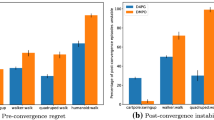Abstract
In this paper, we describe a formal framework for conformance testing of continuous and hybrid systems, using the international standard ‘Formal Methods in Conformance Testing’ FMCT. We propose a novel test coverage measure for these systems, which is defined using the star discrepancy notion. This coverage measure is used to quantify the validation ‘completeness’. It is also used to guide input stimulus generation by identifying the portions of the system behaviors that are not adequately examined. We then propose a test generation method, which is based on a robotic motion planning algorithm and is guided by the coverage measure. This method was implemented in a prototype tool that can handle high dimensional systems (up to 100 dimensions).
Similar content being viewed by others
References
Alur R, Courcoubetis C, Halbwachs N, Henzinger TA, Ho P-H, Nicollin X, Olivero A, Sifakis J, Yovine S (1995) The algorithmic analysis of hybrid systems. Theor Comput Sci 138:3–34
Alur R, Dang T, Esposito J, Hur Y, Ivancic F, Kumar V, Lee I, Mishra P, Pappas G, Sokolsky O (2002) Hierarchical modeling and analysis of embedded systems. In: Proceedings of the IEEE, October 2002
Beck J, Chen WWL (1988) Irregularities of distribution. Cambridge Univ Press, Cambridge
Branicky MS, Curtiss MM, Levine J Morgan S (2005) Sampling-based reachability algorithms for control and verification of complex systems. In: Proc thirteenth Yale workshop on Adaptive and Learning Systems, New Haven, CT
Cheng P, LaValle S (2002) Resolution complete rapidly-exploring random trees. In: Proc IEEE International Conference on Robotics and Automation, pp 267–272
Dang T, Nahhal T (2006) Randomized simulation of hybrid systems. Technical report, Verimag, May 2006
Dobkin D, Eppstein D (1993) Computing the discrepancy. In: Proceedings of the Ninth Annual Symposium on Computational Geometry, pp 47–52
Esposito JM, Kim J, Kumar V (2004) Adaptive RRTs for validating hybrid robotic control systems. In: Int workshop on the Algorithmic Foundations of Robotics
Bhatia A, Frazzoli E (2004) Incremental search methods for reachability analysis of continuous and hybrid systems. In: Hybrid Systems: Computation and Control HSCC. LNCS, vol 2993. Springer, Berlin, pp 142–156
Julius AA, Fainekos GE, Anand M, Lee I, Pappas GJ (2007) Robust test generation and coverage for hybrid systems. In: Hybrid Systems: Computation and Control HSCC. LNCS. Springer, Berlin, pp 329–342
Kim J, Esposito JM, Kumar V (2006) Sampling-based algorithm for testing and validating robot controllers. Int J Rob Res 25(12):1257–1272
LaValle SM, Branicky MS, Lindemann SR (2004) On the relationship between classical grid search and probabilistic roadmaps. Int J Rob Res 23(7–8):673–692
Faure H (1978) Discrépance de suites associees à un système de numération. General theory of distribution modulo 1. In: Irregularities of distribution
Kuffner J, LaValle S (2000) RRT-connect: An efficient approach to single-query path planning. In Proc IEEE Int’l Conf on Robotics and Automation (ICRA’2000), San Francisco, CA, April 2000
LaValle SM, Kuffner JJ (2001) Rapidly-exploring Random Trees: progress and prospects. In: Algorithmic and computational robotics: new directions. AK Peters, Wellesley, pp 293–308
Lee D, Yannakakis M (1996) Principles and methods of testing finite state machines—A survey. In: Proceedings of the IEEE, vol 84, pp 1090–1123
Lindemann SR, LaValle SM (2004) Incrementally reducing dispersion by increasing voronoi bias in RRTs. In: Proceedings IEEE International Conference on Robotics and Automation
Mitchell I, Tomlin C (2000) Level set methods for computation in hybrid Systems. In: Hybrid Systems: Control and Computation HSCC. LNCS, vol 1790. Springer, Berlin
Moore A (1991) A tutorial on kd-trees. Computer laboratory technical report no 209, University of Cambridge, http://www.cs.cmu.edu/~awm/papers.html
Nahhal T, Dang T (2007) Guided randomized simulation. In: Hybrid Systems: Control and Computation. LNCS, vol 4416. Springer, Berlin, pp 731–735
Nahhal T (2007) Model-based testing of hybrid systems. PhD thesis, Joseph Fourier University, October 2007
Plaku E, Kavraki LE, Vardi MY (2007) Hybrid systems: From verification to falsification. In: Damm W, Hermanns H (eds) International Conference on Computer Aided Verification (CAV). LNCS, vol 4590. Springer, Berlin, pp 468–481
Tan L, Kim J, Sokolsky O, Lee I (2004) Model-based testing and monitoring for hybrid embedded systems. In: IRI, pp 487–492
Thiémard E (2001) An algorithm to compute bounds for the star discrepancy. J Complex 17(4):850
Tretmans J (1999) Testing concurrent systems: a formal approach. In: Int Conference on Concurrency Theory CONCUR. LNCS, vol 1664. Springer, Berlin
Tretmans J (1994) A formal approach to conformance testing. In: Proceedings of the IFIP TC6/WG6.1 sixth international workshop on Protocol Test Systems VI. North-Holland, Amsterdam, pp 257–276
Yershova A, Jaillet L, Simeon T, LaValle SM (2005) Dynamic-domain RRTs: efficient exploration by controlling the sampling domain. In: Proc IEEE International Conference on Robotics and Automation
Wang X, Hickernell F (2000) Randomized Halton sequences. Math Comput Model 32:887–899
Zhu H, Hall PAV, May JHR (1997) Software unit test coverage and adequacy. In: ACM Computing Surveys, 29, 4 Dec 1997
Author information
Authors and Affiliations
Corresponding author
Rights and permissions
About this article
Cite this article
Dang, T., Nahhal, T. Coverage-guided test generation for continuous and hybrid systems. Form Methods Syst Des 34, 183–213 (2009). https://doi.org/10.1007/s10703-009-0066-0
Published:
Issue Date:
DOI: https://doi.org/10.1007/s10703-009-0066-0




